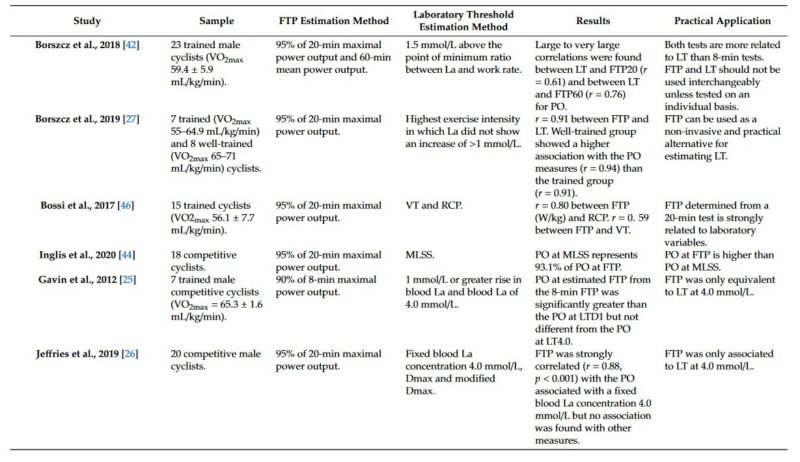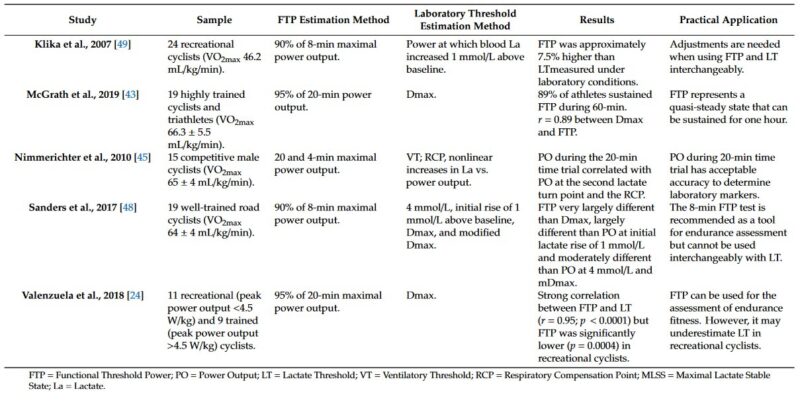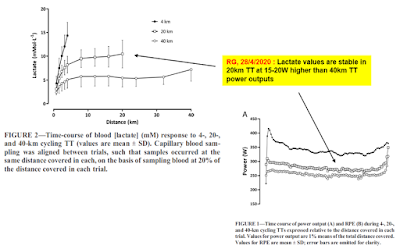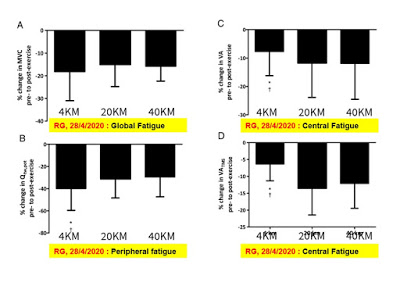Everyone has an opinion on FTP, their own FTP, your FTP, my FTP, their dog’s FTP. There is no denying that FTP has been a success in the sense of giving cyclists something to talk about on dark evenings 😂
It’s also genuinely handy to know we are talking about the same thing…well nearly….I am generally talking about the hugely simplified definition of “best 60min power”. FTP zealots will say that’s *NOT* FTP and I want to kill you for saying it is……..but read on, because no matter what clever definitions of FTP people come up with and no matter how many deadly sins (aka mistakes) people say there are, the big question is: whether FTP is anchored around some definite physiological measure such as anaerobic threshold
So today I am asking is this 20 year old concept still valid? Let’s have a quick look at the latest studies and find out. Lets start by trying to pin this down
Definition of FTP
The definition everyone uses is actually just a rule of thumb:
Your best mean power from your best effort over 60minutes non-stop using an accurate power meter
The definition Andrew Coggan (with/without Hunter Allen) came up with was in the early 2000s was:
The highest power that a rider can sustain in a quasi-steady state without fatiguing
it is also written as
The highest power output that a cyclist can maintain in a quasi-steady-state without fatigue for approximately 60 min.
A quick heads-up that whenever a definition includes the word “approximately something” then it is not “precisely something” and generally that’s not a good start, but lets move on……
Why is FTP Important?
The reason FTP is important is that we use it as a form of everyday calibration. It is very handy (whether its valid or invalid physiologically) because any measure of power/time is a helpful convenience measures in order to
establish training intensity zones
detect changes in performance over time
calculate TSS (and CTL, ATL, and TSB) ie training loads
to predict recovery rates after setbacks
We also use it to compare athletes and plan training (time-in-zone).

How to Validate FTP Physiologically?

In order to validate something you really need to compare it with something known and external (a gold standard)….this is known as criterion validity. In the case of FTP, as per the claims, it is only really valid if it is linked with some concrete physiological measure. It no good to compare 60 min power with 50min power, or 60min power and 20min power….you are just measuring points on the same scale (the power duration curve). Thats just like saying I am a really fast runner over 1500m…do you think I will be fast over 1mile? Duh! The best predictor of performance is performance itself. No shit sherlock!
The fact that 20min power predicts 60min power (LINK) does not prove much unless the two activities have very different physiological demands. Recent performance predicts current performance, ie this is a circularity or a correlation not any kind of validation. So we need to ask at this point is there a definite physiological marker of threshold? This is a big topic in itself, with no 100% clear answer. The entire concept of VT1 and VT2 thresholds and lactate thresholds are hugely debated and in my opinion far from resolved but I point you towards this excellent review paper by Faude in 2009 (full text LINK)
Lactate Testing
OK so lactate testing is meant to be a good proxy of anaerobic threshold (AnT). Essentially there are two types of lactate testing, ramp testing where the difficulty goes up and the lactate goes up pretty sharply when things get tough (onset of blood lactate accumulation aka OBLA), and steady state where there are multiple trials from easy difficulty to hard difficulty and the lactate is in a near steady state (aka MLSS) [7] [8] [9]. OBLA used to be thought of as a definitive kink on the lactate curve, but we now know this was an artifact of low sample size and with large samples and there really is a continuum not a threshold indeed any cut off, eg 4mmol/l is purely convenience. Don’t believe me? Play “find the threshold on fig 3 below! Some people claim they will find the threshold using clever maths. But no matter what clever maths you use (eg Dmax) you still find no kink or step or break point on curves where the same size is large (below). So basically lactate ramp testing is pretty flawed as a gold standard, and MLSS is preferred.



Validation against MLSS
Since ramp lactate testing is very dubious, there is a better but more laborious method in the MLSS. I am not saying MLSS is perfect, but it is close to the best we have for now. The MLSS stands for maximal lactate steady state (MLSS) and is it here that the followers of FTP’s will hope to validate “quasi-steady state”
So ideally we are looking for studies that measured 60min best power (FTP60) (probably indoors in controlled conditions or at a push in a solo timetrial) against MLSS. FTP60 against OBLA would be a bit less interesting, FTP20 vs MLSS would be worthwhile but FTP20 vs OBLA probably wouldn’t. FTP60 vs DMAX? not so good. FTP20 vs DMAX very weak. Get the idea? OK let’s dig deep into the studies….

Validation Studies (in date order)
OK, now we come to the actual data, and its fairly messy and pretty detailed, sorry about that! Here is my best effort at summarizing the FTP validation studies:
 Study 1 (LINK) Pringle and Jones 2012
Study 1 (LINK) Pringle and Jones 2012

This was the first study I could find and looked at critical power not FTP but these concepts are so close, its worth including.8x healthy subjects did four exhaustive trials of between 2 and 15 min duration. The MLSS was determined as the highest power output at which the increase in blood [La] was less than 1.0 mM across the last 20 min of a series of 30-min trials. Critical power was significantly higher than the P-MLSS [242 vs. 222], although the two variables were strongly correlated (r=0.95; P<0.01).
>>results >> Critical power (15mins) was correlated with MLSS but they did not line up very well
 Study 2 (LINK) Gavin 2012
Study 2 (LINK) Gavin 2012
Lactate threshold and FTP were measured in just 7x trained male competitive cyclists. Well you have to start somewhere! FTP was estimated from an 8-minute best power and compared with power at LT using 1 mmol/L change (Δ1) or blood lactate of fixed 4.0 mmol/L. The estimated FTP was close to power at LT4.0 and but greater than power at LTΔ1. Not a good study, but at least they tried.
>>results >> FTP was close to LT4.0 but not to any other measures of lactate threshold
 Study 3 (Link) Sanders 2017
Study 3 (Link) Sanders 2017
Lactate threshold was assessed from a ramp test vs an estimate of functional threshold power (FTP) from 8min timetrial (TT8min) in 19x well-trained road cyclists (aged 22 ± 2 yr, VO2max 64). 8MTT FTP was moderate to very largely different compared to power output at initial rise of 1 mmol/L (ES = 1.37), Power at Dmax (ES = 2.42), Power at mDmax (ES = 0.77) and Powerat 4 mmol/L(ES = 0.83). They said coaches should be cautious when using FTP and Power at laboratory-based thresholds interchangeably to inform training prescription.
>>results >> FTP8min was not closely linked with lactate measures
 Study 4 (Link) Valenzuela 2018
Study 4 (Link) Valenzuela 2018
A total of 20x male cyclists performed an incremental test in which LT was determined. >48 h later, they performed a 20-min time trial, and 95% of the mean power output was defined as FTP. In this study participants were divided into recreational (peak power output < 4.5 W/kg; n = 11) or trained cyclists (peak power output > 4.5 W/kg; n = 9) according to their fitness status.
FTP and LT was closely correlated in trained cyclists, but FTP was significantly lower than the LT in recreational cyclists. However, looked at individually, only about 10% of those tests scored within 5w of their true result (figure).

>>results >> FTP provides a good estimate of LT in trained cyclists but not in recreational cyclists and there is huge variation meaning it was of little practical use.
23x experienced male racing cyclists performed FTP20 FT60ime trials, and a time to exhaustion at FTP20. (VO2 max 59.4)
Power output, heart rate and oxygen uptake representing FTP20, FTP60 and IAT were similar and large to correlations were found (r=0.61 to 0.88). They conclude FTP20 and FTP60 should not be used interchangeably on an individual basis and their validity against IAT should be interpreted with caution. The results displayed a modest correlation between FTP-values derived from the (FTP60) and threshold power estimated by the lactate profile test (IAT) but closer for FTP20. eg FTP60: 231W , FTP20: 236W, Lactate test: 237W
In a blog post Simmons lined up all the results and found most did not line up…. 11 of the 23 riders had a threshold power estimate from the 20 min test that differed by 30–50 watt from that of the lactate profile test. Only 5 of the 23 riders had a 20 min estimate and lactate profile estimate with a difference smaller than 10 watt. Hmm interesting.

>>results >>FTP was roughly correlated with lactate but not reliable to be used individually
 Study 6 (link) Inglis 2018
Study 6 (link) Inglis 2018
This study compared FTP20 and MLSS in 18 participants (12 males: 37 [6] y and 6 females: 28 [6] y) . They performed a ramp-incremental cycling test to exhaustion, 2 to 3 constant-load MLSS trials, and an FTP20 test. FTP20 and FTP95% was greater than that at MLSS (P = .00), with the power output at MLSS representing 88.5% (4.8%) and 93.1% (5.1%) of FTP and FTP95%, respectively.
>>FTP95% is significantly different to MLSS
 Study 7 (link) Heuberger 2018
Study 7 (link) Heuberger 2018
In one of the largest studies 48 well-trained male cyclists aged 18–50 performed 5 maximal graded exercise tests each separated by two weeks. Blood lactate-related thresholds were calculated using eight different representative concepts (named LT1, LT2,LT3, LT5, LT-4mmol/l, Dmax, Dmax-mod) against a 45 minute time trial tests and a road race to the top of Mont Ventoux. There was fair to good correlation with time trial tests but poor with the road race (r = 0.875 for TT1 and 0.82 for TT2, versus 0.61 for RR). the best correlations were with Dmax and LT4mm/L …..BUT even then differences were typically 30w!
>> FTP was moderately correlated to lactate Dmax and LT4mm but not reliably and power “threshold” and lactate “threshold” were different
 Study 8 (link) McGrath 2019
Study 8 (link) McGrath 2019
In this study trained athletes (n = 19) completed four non-randomized tests over successive weeks on a Wattbike; a 3-min incremental test (GxT) to exhaustion, two 20-min FTP tests and a 60-min test at computed FTP (cFTP). Power at cFTP was calculated by reducing 20-min FTP data by 5% and was compared with power at Dmax and lactate threshold (TLac). Ventilatory and blood lactate (BLa) responses to cFTP were measured to determine whether cFTP was quasi-steady state. Moderate agreement between FTP tests was detected (95% LoA = +13 and -17 W, bias +2 W). The 60-min effort at cFTP was successfully completed by 17 participants
>> FTP was moderately related to Dmax and note that 17/19 were able to complete a 60min test!
 Study 9 (LINK) Jeffries 2019
Study 9 (LINK) Jeffries 2019
FTP from TT20minute cycling time trial. 20x competitive male cyclists completed a maximal 20-minute time trial and an incremental exercise test to establish a range of blood lactate parameters. FTP(266 ± 42 W) was strongly correlated (r = 0.88, p < 0.001) fixed blood lactate concentration 4.0 mmol/L. All other lactate parameters, lactate threshold (LT) (236 ± 32 W), individual anaerobic threshold (244 ± 33 W), and LT thresholds determined using the Dmax method (221 ± 25 W) and modified Dmax method (238 ± 32 W) were significantly different from FTP (p < 0.05).
>> FTP correlated with LT4.0 but not any other measures of threshold
This study looked at FTP20 in predicting MLSS. Method: Fifteen cyclists, 7 classified as trained and 8 as well-trained performed an incremental test to exhaustion, an FTP test, and several constant load tests to determine the MLSS. FTP has strong correlation (r = 0.91) with MLSS in all cyclists together. When divided by the training level, the bias ± 95% LoA and TEE were higher in the trained group (1.4 ± 11.8% and 6.4%, respectively) than in the well-trained group (1.3 ± 7.4% and 3.0%, respectively).
>> FTP20 was related to MLSS in this small study

Study 11 (LINK) Lillo-Beviá 2019
This study compared a 20min TT with maximal lactate steady state (MLSS)as well as ventilatory thresholds and VO2max measured by indirect calorimetry. Results revealed that MLSS differed substantially from TT20 (bias = 26 ± 7 W).
>FTP20 was not closely linked with MLSS

Study 12 (LINK) Sørensen 2019
This group looked at 11 mountain bikers and compared a 20min FTP test with VO2max test in lab with MTB race results. There was little correlation between any of these variables (see chart of person correlations)….
FTP20 was not closely linked with VO2Max

Five New Studies!
Since I posted this blog in 2019, there has been at least 5x new studies ; as well as two new review articles
 Study 13 (LINK) Inglis et al 2020
Study 13 (LINK) Inglis et al 2020
This study compared a 20min TT with maximal lactate steady state (MLSS) in 18 competitive cyclists. Power at MLSS imprecisely matched power at FTP20 uncorrected (88%) and FTP20 (93%) using the 95% rule. They conclude “the large variability in the data is such that it would not be advisable to use this as a representation of MLSS”.
FTP20 was not closely linked with MLSS
 Study 14 (LINK) Karsten 2020
Study 14 (LINK) Karsten 2020
This group examined 17 trained cyclists using a strong protocol of maximal incremental ramp test, a single-visit CP test and a 20-min time trial (TT) test in randomized order on three different days. CP was determined using a time-trial (TT) protocol of three durations (12, 7, and 3 min) interspersed by 30 min passive rest. There was a 91.7% probability that CP (256 ± 50 W) was higher than FTP (249 ± 44 W). With relatively large ranges for limits of agreement between variables, these values generally should not be used interchangeably.
FTP20 was not closely linked with critical power measures
 Study 15 (LINK) McGrath 2021
Study 15 (LINK) McGrath 2021
This study compared three critical power models from VO2max ramp testing with 95% FTP20 protocol. CP data derived from all three models were found to be significantly higher than FTP and consequently we can reject the null hypothesis that the two tests can be used interchangeably in a highly-trained athletic cohort
FTP20 was not closely linked with ramp tests/critical power
 Study 16 (LINK) Jeffries 2021
Study 16 (LINK) Jeffries 2021
This group compared results in 20 cyclists compared from a 20min TT and incremental test with blood lactate. FTP was correlated with (r = 0.88, p < 0.001) with the power output associated with a fixed blood lactate concentration 4.0 mmol·L−1 (LT4.0) but not with any other lactate measures. The large limits of agreement refutes any equivalence (of FTP) as a measure with physiological basis.
FTP20 was correlated but LT4 but with large variability
 Study 17 (LINK) Lillo-Bevia 2022
Study 17 (LINK) Lillo-Bevia 2022
This study compared a 20min TT with maximal lactate steady state (MLSS) in 11 trained cyclists. Validity results revealed that MLSS differed substantially from TT20 (bias = 26 ± 7 W).
FTP20 was not closely linked with MLSS
Table of Results
(from Sitko 2020)


Nit Picking
Returning to the definition we can break it down into its parts, and see if they stand-up individually……
The highest power output that a cyclist can maintain in a quasi-steady-state without fatigue for approximately 60 min.
Becomes
A. highest power at quasi-steady-state
B. highest power without fatigue
C. highest power over approximately 60 min
Ron George has done a great job of analyzing these here
A. highest power at quasi-steady-state can be much higher than perfectly flat FTP power

B. highest power without fatigue, is pretty much zero. Central and peripheral fatigue is very prominent even in a 4km (5mins) TT

Why would your physiology and indeed every person’s ever born, know that approximately one hour was critical to their cycling ability, especially when the bicycle was invented only 200 years ago in the last 0.01% of human evolution? It turns out there is no real verification of “60mins” except Coggan claims that proof is in a small sample of 200 cyclists show FTP to be 60 +/- 13 min but the proof is in a top secret algorithm hidden in WKO4 / WKO5.
Conclusions
Wow that’s a lot of data and very messy!
FIVE quality studies compared FTP with MLSS and of these 1 small study found a good correlation BUT all larger studies found a poor correlation
EIGHT lesser quality studies that compared FTP with lactate ramp tests, either fixed LT4.0mml/L or Dmax then nearly all showed a fair correlation (eg r=0.7)…..but this correlation turned out to be practically fairly useless (because it is typically an absolute difference of around 20w–40w between the two methods), and on an individual basis the results did not “line-up” as expected. This is the same kind of observation between let’s saying smoking and alcohol. Both are fairly well correlated in the population…..yet imagine if you say said to a heavy smoker, hey man you should really cut down your alcohol use……you would be risking a punch in the face, not to mention being statistically wrong in terms of agreement too many times to make this a sensible strategy.
Several studies compared FTP with VO2max/ramp/critical power with generally poor correlation; which is suprising as this is the weakest method essentially comparing one power measurement with another (without any true physiological metric).
So we can conclude there is a rough relationship between FTP and some measure of blood lactate but it is far from convincing in terms of meeting a “gold standard validation” of FTP. It is also so approximate that it is of little practical use. The term “without fatigue” is ludicrously incorrect, and I can only assume he meant to say “without significant decline in power”. Also I do not find that the lactate results validate any kind of special “threshold” status at 60mins, or indeed 45mins or 30mins. FTP could be defined as power over 37mins and it will work just as well. NOTHING special happens physiologically at 60mins, or approximately 60mins as far as I can see. VT1 and VT2 probably do exist on an individual basis and can be compared against your own values (change scores following training), but I do not think they can be precisely pinned down to a fixed value in the population.
In my opinion the entire idea of a threshold needs a thorough reexamination by scientists who have no vested interest. Anyone who loves or hates FTP probably wouldn’t be objective enough….so thinking about it, that includes me. Bye. Forget I said anything 😂 😂

Further Interesting Reading:
Citations
Pringle, J.S.M. & Jones, A.M. (2002): Maximal lactate steady state, critical power and EMG during cycling. Eur J Appl Physiol, 88:214–226.
Gavin, TP, Van Meter, JB, Brophy, PM, Dubis, GS, Potts, KN, and Hickner, RC. Comparison of a field-based test to estimate functional threshold power and power output at lactate threshold. J Strength Cond Res 26(2): 416–421, 2012
Sanders D1, Taylor RJ, Myers T, Akubat I .A field-based cycling test to assess predictors of endurance performance and establishing training zones .J Strength Cond Res. 2017 Mar 25. doi: 10.1519
Valenzuela PL, Morales JS, Foster C, Lucia A, de la Villa P .Int J Sports Physiol Perform. 2018 Nov 20:1–6. doi: 10.1123/ijspp.2018–0008. [Epub ahead of print]Is the Functional Threshold Power a Valid Surrogate of the Lactate Threshold?
Klitzke Borszcz F, Ferreira Tramontin A, Pereira Costa V .Is the Functional Threshold Power Interchangeable With the Maximal Lactate Steady State in Trained Cyclists ?Int J Sports Physiol Perform. 2019 Sep 1;14(8):1029–1035. doi: 10.1123/ijspp.2018–0572.
Inglis EC, Iannetta D, Passfield L, Murias JM International Journal of Sports Physiology and Performance, 04 Nov 2019, :1–7 DOI: 10.1123/ijspp.2019–0214 PMID: 3168968
Heuberger JAAC1, Gal P1, Stuurman FE1, de Muinck Keizer WAS1,2, Mejia Miranda Y1, Cohen AF1,3 .Repeatability and predictive value of lactate threshold concepts in endurance sports .PLoS One. 2018 Nov 14;13(11):e0206846. doi: 10.1371/journal.pone.0206846. eCollection 2018.
McGRATH E, Mahony N, Fleming N, Donne B. Is the FTP Test a Reliable, Reproducible and Functional Assessment Tool in Highly-Trained Athletes? International Journal of Exercise Science 12(4): 1334–1345, 2019.
Jeffries, O, Simmons, R, Patterson, SD, and Waldron, M. Functional threshold power is not equivalent to lactate parameters in trained cyclists. J Strength Cond Res XX(X): 000–000, 2019
Klitzke Borszcz F, Ferreira Tramontin A, Pereira Costa V.Is the Functional Threshold Power Interchangeable With the Maximal Lactate Steady State in Trained Cyclists? International Journal of Sports Physiology and Performance 14(8):1029–103
Lillo-Beviá, JR, Courel-Ibáñez, J, Cerezuela-Espejo, V, Morán-Navarro, R, Martínez-Cava, A, and Pallarés, JG. Is the functional threshold power a valid metric to estimate the maximal lactate steady state in cyclists? J Strength Cond Res XX(X): 000–000, 2019
